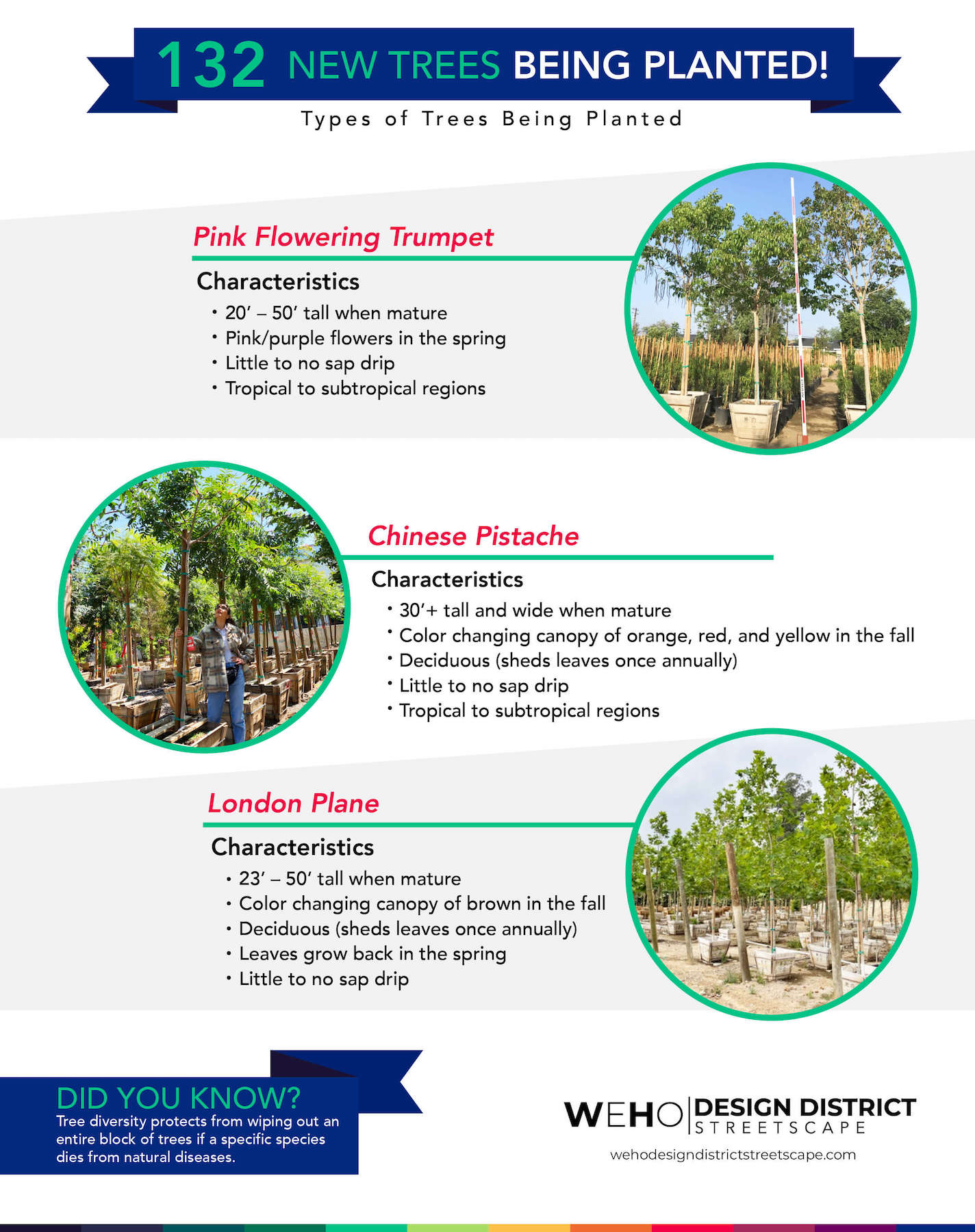Trees are a significant part of any neighborhood’s ecosystem and atmosphere. Construction crews have begun to remove the old trees along Melrose Avenue and WeHo residents are understandably concerned. Fortunately, trees are a central part of the WeHo Design District Streetscape Project!
132 NEW TREES ARE BEING PLANTED!
Please see below for more information on the trees on Melrose Avenue, both the removal of the existing trees and the plans for the new trees that will line Melrose in the near future.
Why are the existing trees on Melrose being removed?
Some of the existing trees are causing damage to underground utilities and creating a walking hazard for pedestrians. In addition, to ensure wider sidewalks and add more green space through new parkways, a comprehensive approach to matching safety, user experience for pedestrians and business, and city goals for climate responsive trees that are integrated into the overall layout is necessary.
What types of trees will be planted and why were they selected?
Expanded and extensive tree canopies are a central component of the Design District. Based on the plan, the district was to have a larger district-wide tree, plus two trees per street that would help build the identity of that street. Tree diversity protects from wiping out an entire block of trees if a specific species dies from natural diseases.
Trees were vetted by the City’s Urban Forester to ensure they were appropriate for our climate and ensure that the trees would not have issues related to sap or expanding roots. A fast growth rate and aesthetically pleasing appearance were additional considerations.
Beyond beautification, newly selected canopy trees will play a major role in:
- Regenerating the city’s ecosystem by enhancing rainwater capture
- Adding biodiversity that promotes wildlife nesting and pollination
- Supporting resilience to protect against infestation or disease
- Restoring the richness of the city’s soil by removing concrete and increasing parkways with the trees
- Providing natural, ample shade for pedestrians, while at the same time combating heat island effects caused by direct sun exposure on to hard surfaces.
In effect, with approximately 40 additional trees being introduced into the District, the combination of the three selected species (Pink Flowering Trumpet, Chinese Pistache, and London Plane) will establish a much more environmentally responsive and higher performing micro-climate for the community going forward.
What will the new trees look like?
When the new trees are planted, they will be approximately 9’ – 11’ tall and 3’ – 5’ wide. This tree size is optimal because of higher survival rates and capability to produce healthier trees. The City has undergone extensive inspections and discussions with arborists, urban foresters, and landscape architects; however, the likelihood of tree survival for the replanting of existing trees is extremely low. Below are descriptions and photos of the three tree species selected.
Types of Trees Being Planted
Pink Flowering Trumpet
Characteristics of Pink Flowering Trumpet:
- 9’ – 11’ tall and 3’ – 5’ wide when first planted
- 20’ – 50’ tall when mature
- Pink/purple flowers in the spring
- Little to no sap drip
- Tropical to subtropical regions
Chinese Pistache
Characteristics of Chinese Pistache:
- 30’+ tall and wide when mature
- Color changing canopy of orange, red, and yellow in the fall
- Deciduous (sheds leaves once annually)
- Little to no sap drip
- Tropical to subtropical regions
London Plane
Characteristics of London Plane:
- 23’ – 50’ tall when mature
- Color changing canopy of brown in the fall
- Deciduous (sheds leaves once annually)
- Leaves grow back in the spring
- Little to no sap drip
New renderings of Melrose Avenue Streetscape are being developed – check this website or sign-up for project email updates.
